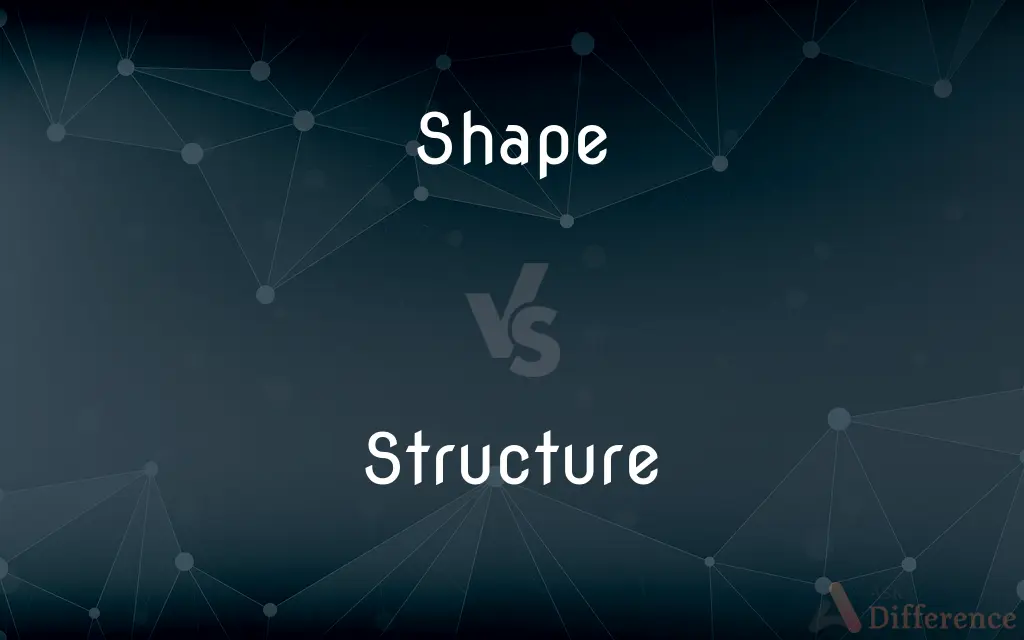Shape vs. Structure — What's the Difference?
Edited by Tayyaba Rehman — By Maham Liaqat — Updated on March 1, 2024
Shape refers to the external form or appearance of an object, defined by its outline or contour. Structure describes the arrangement or organization of parts within an object, determining its composition and stability.

Difference Between Shape and Structure
Table of Contents
ADVERTISEMENT
Key Differences
Shape is the visual attribute that defines the outline or surface configuration of an object, readily perceived by the eye. It is one of the first aspects noticed about an object, whether it's geometric (like circles and squares) or organic (like the shapes of trees and rivers). Structure, on the other hand, delves deeper into how an object is made or built, focusing on the internal framework that supports it, whether it's the skeleton of a living organism or the steel beams in a building.
Shape is primarily concerned with aesthetics and visual identification, structure is about functionality and integrity. The shape of an object can be changed without affecting its structure, such as molding clay into different forms. Conversely, altering the structure of an object, like removing a load-bearing wall in a building, can significantly impact its stability and function, irrespective of its external shape.
Shapes can be two-dimensional or three-dimensional, influencing how we categorize and relate to objects in space. Structures define how parts of an object or system are connected and how they work together to form a coherent whole, emphasizing the object's physical properties and how they withstand forces and load.
The concept of shape is used extensively in various fields, including art, design, and geometry, as a fundamental element of composition and aesthetic appeal. Structure finds its relevance in engineering, architecture, biology, and social sciences, highlighting the importance of organization, hierarchy, and relationship between components within systems.
Shape and structure may intersect in the design and analysis of objects, they serve distinct roles: shape as a key element of visual identification and aesthetic, and structure as the backbone that ensures functionality, stability, and durability.
ADVERTISEMENT
Comparison Chart
Definition
The external form or appearance of an object.
The arrangement or organization of parts within an object.
Focus
Aesthetics and visual identification.
Functionality, integrity, and organization.
Dimensionality
Can be 2D or 3D.
Primarily 3D, considering spatial organization.
Fields of Relevance
Art, design, geometry.
Engineering, architecture, biology, social sciences.
Impact of Change
Changing shape does not necessarily affect the object’s structure.
Altering structure can significantly affect an object’s function and stability.
Compare with Definitions
Shape
Circle.
The artist drew a perfect circle, showcasing its simple shape.
Structure
Skeletal.
The skeletal structure of vertebrates is made up of bones.
Shape
Square.
The child's toy blocks were mostly in square shapes.
Structure
Architectural.
The building's structure was designed to withstand earthquakes.
Shape
Organic.
The shape of the lake was irregular, mimicking an organic form.
Structure
Social.
The social structure of the community was hierarchical.
Shape
Abstract.
Modern art frequently explores abstract shapes that defy conventional forms.
Structure
Molecular.
Water's unique properties are due to its molecular structure.
Shape
Triangle.
Traffic signs often have a triangular shape for warnings.
Structure
Organizational.
The company's organizational structure was redesigned for efficiency.
Shape
A shape or figure is the form of an object or its external boundary, outline, or external surface, as opposed to other properties such as color, texture, or material type. A plane shape, two-dimensional shape, or 2D shape (plane figure, two-dimensional figure, or 2D figure) is constrained to lie on a plane, in contrast to solid figures.
Structure
A structure is an arrangement and organization of interrelated elements in a material object or system, or the object or system so organized. Material structures include man-made objects such as buildings and machines and natural objects such as biological organisms, minerals and chemicals.
Shape
The characteristic surface configuration of a thing; an outline or contour
A lake in the shape of an hourglass.
Structure
The arrangement of and relations between the parts or elements of something complex
The two sentences have equivalent structures
The company's weakness is the inflexibility of its management structure
Shape
Spatial form, contour, or appearance
The sandy coastline is always changing shape.
Structure
A building or other object constructed from several parts
The station is a magnificent structure and should not be demolished
Shape
The body or outward appearance of a person or an animal
Saw two shapes walking toward her in the night.
Structure
Construct or arrange according to a plan; give a pattern or organization to
Services must be structured so as to avoid pitfalls
Shape
Shape or influence; give direction to;
Experience often determines ability
Mold public opinion
Structure
Something made up of a number of parts that are held or put together in a particular way
Hierarchical social structure.
Shape
Make something, usually for a specific function;
She molded the riceballs carefully
Form cylinders from the dough
Shape a figure
Work the metal into a sword
Structure
The complex composition of knowledge as elements and their combinations;
His lectures have no structure
Shape
Give a shape or form to;
Shape the dough
Structure
A particular complex anatomical structure;
He has good bone structure
Structure
The people in a society considered as a system organized by a characteristic pattern of relationships;
The social organization of England and America is very different
Sociologists have studied the changing structure of the family
Structure
Give a structure to;
I need to structure my days
Common Curiosities
Is shape important in design?
Yes, shape is crucial in design for aesthetics, functionality, and the conveyance of meaning or purpose.
Can the structure of an object be visible from the outside?
While the structure is often internal, some aspects can be visible, such as the beams of a bridge, indicating how parts are interconnected.
Do artists consider structure when creating works?
Artists may consider structure in terms of composition and how elements of their work relate to each other, even if not in the engineering sense.
How do shape and structure relate to each other?
While distinct, shape and structure can influence each other, especially in design and architecture, where the form must often follow function.
Can the same shape have different structures?
Yes, objects with the same shape can have different internal structures, affecting their properties and how they function.
How are shape and structure taught in education?
They are taught through subjects like art, mathematics, and science, highlighting their importance in diverse fields.
How does shape affect an object's appearance?
Shape determines an object's appearance through its outline or contour, influencing visual perception and identification.
How does structure contribute to an object's strength?
The structure provides stability and strength, determining how an object withstands forces and supports weight.
Can changing the shape of an object change its function?
Changing the shape can affect function, especially if it alters how the object interacts with its environment or users, without necessarily changing its internal structure.
What role does geometry play in shape and structure?
Geometry provides the mathematical foundation to understand and manipulate shapes and structures, essential in design and engineering.
Why is understanding structure important in engineering?
In engineering, understanding structure is essential for designing objects that are safe, durable, and efficient.
How do materials affect structure and shape?
Materials influence both the possible shapes an object can take and its structure, impacting durability, weight, and utility.
Can understanding shape and structure improve problem-solving skills?
Yes, understanding these concepts can enhance problem-solving by fostering a deeper comprehension of how things are made and function.
What is the future of studying shape and structure?
Advancements in technology and materials science continue to expand the possibilities for innovative shapes and structures in various domains.
Is the structure always fixed for a given object?
The structure can be designed to be adaptable or changeable in some objects, allowing for flexibility in function or use.
Share Your Discovery

Previous Comparison
Aggregate vs. ConsolidatedNext Comparison
Tracker vs. CrackerAuthor Spotlight
Written by
Maham LiaqatEdited by
Tayyaba RehmanTayyaba Rehman is a distinguished writer, currently serving as a primary contributor to askdifference.com. As a researcher in semantics and etymology, Tayyaba's passion for the complexity of languages and their distinctions has found a perfect home on the platform. Tayyaba delves into the intricacies of language, distinguishing between commonly confused words and phrases, thereby providing clarity for readers worldwide.















































